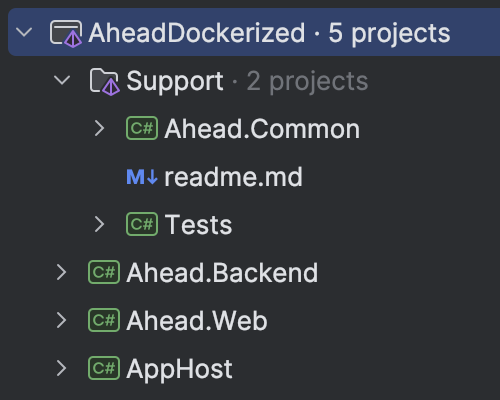Cloud Agnostic - introducing the AheadDockerized .NET Solution
Cloud agnostic series
- Depending on a colour
- Depending on a colour Pt. 2 - Needs, Possibilities and Limitations
- Cloud Agnostic - introducing the AheadDockerized .NET Solution
- ☁️ Agnostic - Storing & serving files
- ☁️ Agnostic - Messaging between servers with RabbitMQ (Queueing)
- ☁️ Agnostic – Messaging between servers with RabbitMQ (Publish/Subscribe)
- ☁️ Agnostic – Intermezzo: Insightful spans with OpenTelemetry
- ☁️ Agnostic – On gremlins and graphs
Let’s quickly revisit where we’re coming from—and where we’re headed:
Keep using as much code as possible from the azure-based product ahead
The existing code is split into multiple C# projects and the single page application frontend, a frontend built with Next.js and pre-rendered into static pages. The following posts won’t cover the frontend - we assume that, given the same endpoints as today, it will keep working no matter where the backend code is hosted.
Reduce dependencies on platform-as-a-service offerings from azure as much as possible to allow running ahead on EU servers offered by EU legal entities
As previously established, there is currently no alternative with the same breadth and depth of service offerings as the big US cloud platforms. So what we will have to do is to lean heavily into containerization. In Europe, providers can be found that will offer hosting containers, or managed Kubernetes environments (In fact, you may even find PaaS offerings that cover your needs). While this adds a layer of complexity in terms of managing scalability, roll out upgrades and related operational tasks, it results in a more cloud-agnostic product.
How is the proof of concept built?
Setting up a cloud native .NET application today means that one must take a look at Aspire. According to Microsoft
.NET Aspire improves the experience of building apps that have a variety of projects and resources. With dev-time productivity enhancements that emulate deployed scenarios, you can quickly develop interconnected apps.
As the second, implicit, mission of the proof-of-concept (PoC) being built is to let me learn about how dotnet has advanced as a platform in the past years (evolving a product that earns money means you can’t always throw the newest and shiniest at it) and as Aspire promises a great local development experience, which is ideal for a PoC, it seemed a natural choice to describe the solution and its dependencies with the aid of Aspire.
The basic structure of the solution (which you can find here on github) looks like this:

- The Web project represents the user-facing process with web pages and endpoints.
- The Backend project is the process that will handle asynchronous workloads
- The AppHost project contains the code that is Aspire-specific and gives us the capability to have a local (i.e. developer machine) representation of how the different pieces of the solution interact with each other.
The next post will look at how we can go about replacing the Azure Blob Storage dependency.